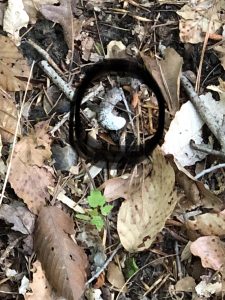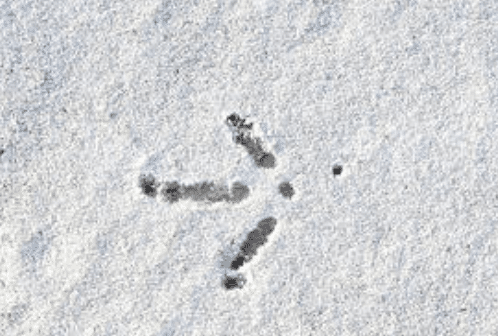Turkey hunting can be one of the most fun sporting activities of your life, but it is also one of the most challenging. The rush of calling back and forth with a group of Turkeys hidden somewhere in the woods is one of the most addictive hobbies I have ever experienced. The locating + calling strategy, and the excitement of getting one to come in close is hard to beat! One of the hardest things about turkey hunting is locating where turkeys are spending their time day in and day out.. Turkeys frequent creek bottoms, open hardwoods, thick ground cover and fields, depending on the time of year. A common question new turkey hunters have is, How do you locate a turkey for hunting? In the following, I’ll dive deep on locating turkeys, and
Turkey Sign
The best way to go about finding a turkey to hunt is to look for sign. Turkeys have several common ways to leave sign in the woods. The first is scratching, which consists of a turkey moving leaves and debris off the ground, so that it can find food, such as grubs, bugs and other small edible items in the soil.
Looking for Turkey Scratching
Scratching looks like this. Sometimes it is very substantial, and looks like someone has taken a leaf rake, and moved circular small piles all over the forest floor. Ive seen this most often in hardwood creek bottoms, and in big pines. These shouldn’t be confused with deer scrapes, as you will most often find these early in the spring, and there are many small areas like this within 100 years of each other in a concentrated area.

They often do this in damp areas so they can move the dirt around. Looking for scratching near creek bottoms is often very effective.
What Do Turkey Droppings Look Like?
In addition, you may be able to find turkey droppings from where they are roosting. This will typically be an adult finger sized in the colors white and gray . It would look something like:

Another sign of turkeys is an area is dusting, as turkeys will wallow in dry areas and create what is called a dusting bowl. It is a round area about 2 feet wide, where they spread the dirt in a circle. They do this similar to chickens, called a dirt bath, as the birds throw dirt on their backs, and literally bathe in the dirt.
Where Turkeys Roost
Turkeys typically like to roost near water, or on the edge of a field. 30 to 60 feet up in the air. Once you find some sign, you can arrive in the early morning to an area that you think turkeys are staying in. You can often locate them by an owl call, or a crow call as daylight begins to break. Using an owl call is the most effective in my experience, as you can get them to gobble as they think there’s an owl nearby. A common pattern that you can use to in and out calls with sound like. “Who cooks for you”, “Who cooks for you too”. Making those sounds in the owl call simulates a real owl and what they sound like in the wild. Near by gobblers will often react to an owl call, and gobble back at the sound. Interesting fact about an owl call it often early in the day, turkeys will gobble form the limb before coming down from the roost. With that said, don’t assume when you hear one early, they will always be on the way to your spot.
Turkey Tracks
In addition to scratching and droppings. You can also find turkeys by their tracks, especially after it has rained, or in a damp area where they may be crossing a creek or a low area in a creek bottom turkeys. Turkey tracks are a little smaller than a adult hand.

Turkey Diet
Turkeys love to eat bugs, grubs, clover, rye and wheat as well so if you have a field, or a farm nearby that has those items in a pasture then you can often find them there. The later in the spring season, the more vocal turkeys will be as they start to find hens and gather up in groups. The gobblers will be more vocal and try to grow their group, as the season progresses.
After you find the sign
Plan to get out before the sun rises, and creep into the area where you have found sign. Especially if you have a good idea of where they are roosting. Once day breaks, sit quietly and wait to see if you can hear a turkey. Many times they will gobble before they fly down from the roost, which typically happens about 30 minutes after daylight. As turkeys begin to gobble on the roost, and once they hit the ground, you may then start to use a turkey call to get them to respond. Doing light and Yelp’s on a box call or glass call are very effective in the early morning. The sound carries along way, and sounds super realistic. I wouldn’t do this too aggressively, as in the morning turkeys typically start off fairly calm. Doing a few hen yelps will get the turkeys interest. If you have a decoy, and can see them on the roost, you can sometimes get their attention and draw them toward the decoy by making soft yelps. Check out our article on how to use turkey decoys to maximize your turkey hunts here.
What if you picked the wrong spot?
If you set up to locate turkeys and don’t find any after daylight, they may be out of range from where you can hear them. I would recommend spending 15 to 30 minutes in a spot before moving. If you don’t have any luck, then move on to another area that you think may have turkeys in it, or you have seen other signs in the area. Setting up with your turkey call and or owl call, and see if you can get one within hearing range. As you do this. Make note of where your turkeys are located.
“Cutting and Running”
Some folks prefer to do something called Cutting and Running, which is a turkey term for walking and calling to begin you day, and basically walking and calling some more until you find the birds, and then get set up. It’s easier to cover more ground, but can sometimes hurt your chances of seeing Turkey.
Marking Your Turkey Sign
You can even map them on something like On X which is a hunting map resource that I have linked right here OnX Hunting App. On X is a mobile phone app that allows you to mark things like turkey sign, deer sign, deer stands, blinds, fields trails, blood trails, property lines, and other things. You can also share your, your pins and placements with friends if you are hunting together. Overall, your best bet at finding a turkey is to get out early in the season, and walk the woods, as much as you can.
Recap on How Do You Locate A Turkey For Hunting
Looking in the areas that we talked about earlier which are creek bottoms, open hardwood areas, field edges and anywhere that you can find water turkeys will often roost near water, and are using damp areas to find food.
As a side note, turkeys typically will lay eggs and bed where they can see around them without being exposed in a field. A cutover with medium to low growth in it is ideal for turkeys as they will bed and lay their eggs up against a stump, or brush pile and stay there until they are run off, or eggs hatch.
While you are here, you may want to check out:
- 5 Best Places To Hang A Tree Stand
- Meet Greg, the Author of Proper Hunting
- Best skinning knives of the year!
Hopefully this is helpful, and will lead you to find lots of turkeys and have lots of fun hunting. Best of luck out there. Hope to see you in the woods.
